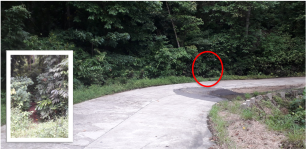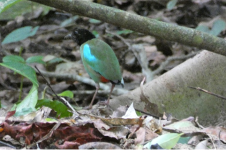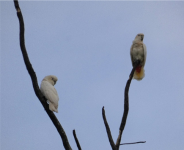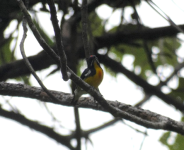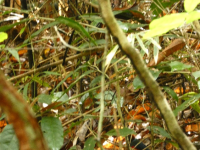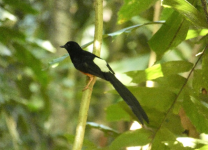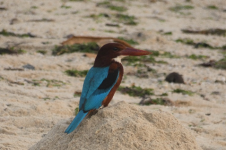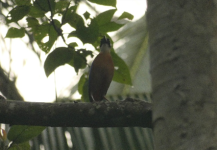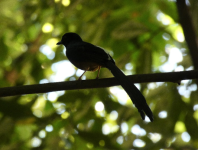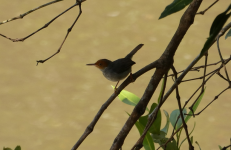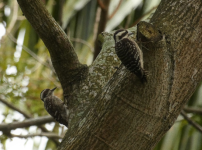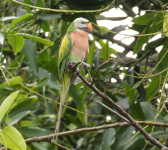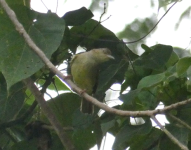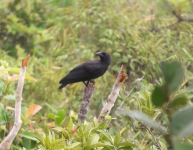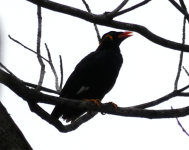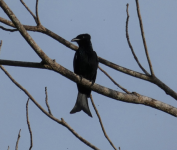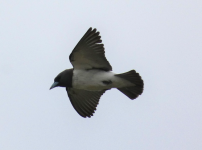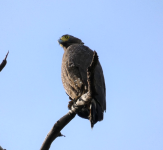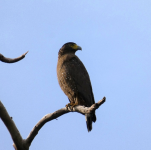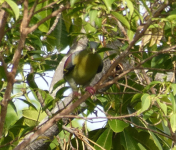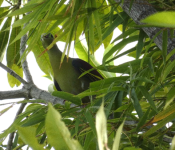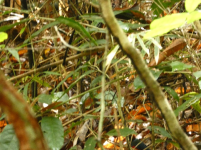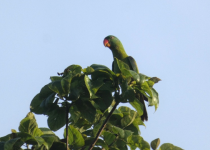dwatsonbirder
Well-known member
This is probably a bit premature as we don't head out until Monday, but just in case any of this info is helpful for anyone planning a trip at present...
Introduction
Aside from a couple of brief trips to Europe, this was the first major trip Kathi and I had made together since the Covid-19 pandemic, and more importantly was our belated honeymoon after spending too much money on our wedding in 2022!
Our original plan had been to spend a week in Singapore, followed by a return to Sabah for a slightly longer trip, but the escalating prices as a result of the global cost of living crisis following the pandemic combined with unworkable logistics meant we had to discount that idea fairly rapidly. Further logistical challenges were posed by the flights to Palawan, eventually we managed to make a workable schedule by flying out via Manila, and returning via Cebu.
Having last visited South-East Asia in 2015, a return was overdue, and following a few recommendations we settled on the island of Palawan as a compromise of decent birding, excellent snorkeling, and generally looking like a stunning place for a honeymoon, with the added bonus of Philippine hospitality. Unfortunately, the outlook for our trip didn’t look too good a week or so before we headed out, with Typhoon Mawar moving west across the Pacific bringing an increased chance of high winds and heavy rain.
Prior to the trip, I had agreed that it wouldn’t be 24/7 birding given the fact it was our honeymoon, and that I would limit my birding mostly to mornings, save the odd half day or dusk/nocturnal escapade. As a result, that meant that some species were completely off the cards due to logistics (such as Mantanani Scops Owl, Palawan striped-babbler and Philippine Shortwing) and despite booking a couple of days at the Subterranean River National Park, the “holy grail” bird that is Palawan Peacock-pheasant was very unlikely, particularly since the habituated male bird died in 2021. As a result, I had to limit my horizons, and my key targets for the Philippine leg of the trip were; Hooded and Philippine Pittas, Falcated wren-babbler, Red-vented cockatoo, Blue Paradise flycatcher, and whatever other endemics I could stumble onto.
The week in Singapore was shortened to 3.5 days due to a combination of logistics and price (I clearly hadn’t done my research on the world’s most expensive city!), but the schedule was more open to birding, and I had hoped to target the following; Jambu fruit-dove, Sulphur-headed bulbul, Mangrove and Blue-winged Pittas, Brown Wood-owl and Red-legged Crake. Rather helpfully, I had exchanged some gen with Pete from Birdforum (@foresttwitcher) who very kindly reciprocated by sending me pins for several species a couple of weeks before I was due to fly out.
Useful information
Singapore
There are a range of excellent resources online to keep up-to speed with the Singaporean birding scene, with a particularly active ebird community. A useful (if out of print) book is A Naturalist's Guide to the Birds of Singapore, which despite being a photographic guide has some useful information on locations, as well as providing the status of some 280 most commonly occurring species in Singapore. It is also less unwieldy than the larger (but otherwise excellent) Helm series covering Peninsular Malaysia and Singapore, making a useful reference (and weight saving alternative) if you are only visiting for a short period of time.
The following websites are also highly recommended:

 Singapore Birders | Facebook (Singapore Birders)
Singapore Birders | Facebook (Singapore Birders)
Log in to Facebook (Singapore Nature Group, good for other wildlife)
Palawan
Information on Palawan is somewhat more limited, and I am indebted to Rob Hutchinson of Birdtour Asia for very kindly providing me with some recent information for several species, as well as hints and tips for seeing some of the trickier species. As always, ebird was useful in providing updates from others birding around the same time, giving some suggestion of what had been seen and where. During my last visit to the Philippines the only guide available was the Kennedy book, which I am pleased to say has been substantially superseded by the excellent Lynx edition - taxonomically up to date at the time of my trip, with excellent maps, status information and accurate illustrations - highly recommended!
I did find the following reports which have some really useful information:
Other information
We had decided to shop around to hire a car for the Palawan leg of the trip, and most places were quoting 1500 php per day for a basic car. We tried booking in advance via Sabai car rental (recommended elsewhere) but sadly ended up going in circles without receiving confirmation or info on how to pay. In the end we opted for Rent-a-car Palawan, Rey was very helpful and responsive with booking, and we were able to pay in advance via paypal - 12,200php for three days rental, including meet and greet at Puerto Princesa Airport and collection from our hotel in Sabang. Cash machines were apparently not present on Palawan, which meant that we had to carry a large amount of php around with us for the first leg, not ideal. We decided to stay at the rather upmarket (for us) Daluyon Beach Resort for our time in Sabang, as this was one of the only hotels to offer tours of the Underground River without the bureaucracy of having to obtain tickets in advance from the park HQ in Puerto Princesa. The price was substantially higher (2000php v 1200php) doing it this way, but it saved additional stress and time spent doing less fun activities.
In Singapore, we opted to stay at the Changi Village Hotel. Again, this was a somewhat more salubrious accommodation option for us, but we decided that the proximity to the airport and fairly decent transport links would make for a better option than staying downtown - also within our budget, most central options were overpriced and a bit crap. Getting around in Singapore is relatively easy thanks to government subsidisation of taxis - the Grab app seems to be the best way of getting around and also allows you to budget for each journey without any risk of being overcharged.
I took a telescope with me on the premise that it may be best to have one and not need it, than the other way around. I used the Bird Call Xeno app to download calls onto my phone in the hope that listening to some of the targets before the trip would stick, the app was very useful for comparison in the field as well as for playback on a couple of occasions. I also pre-loaded locations for trail heads and viewpoints into google maps to use (particularly in Palawan) as some locations seem to have fallen into disrepair in the last few years and have been tricky to locate on the ground.
I'll update this section once we've been on the trip - will report back in full sometime in late June!
Introduction
Aside from a couple of brief trips to Europe, this was the first major trip Kathi and I had made together since the Covid-19 pandemic, and more importantly was our belated honeymoon after spending too much money on our wedding in 2022!
Our original plan had been to spend a week in Singapore, followed by a return to Sabah for a slightly longer trip, but the escalating prices as a result of the global cost of living crisis following the pandemic combined with unworkable logistics meant we had to discount that idea fairly rapidly. Further logistical challenges were posed by the flights to Palawan, eventually we managed to make a workable schedule by flying out via Manila, and returning via Cebu.
Having last visited South-East Asia in 2015, a return was overdue, and following a few recommendations we settled on the island of Palawan as a compromise of decent birding, excellent snorkeling, and generally looking like a stunning place for a honeymoon, with the added bonus of Philippine hospitality. Unfortunately, the outlook for our trip didn’t look too good a week or so before we headed out, with Typhoon Mawar moving west across the Pacific bringing an increased chance of high winds and heavy rain.
Prior to the trip, I had agreed that it wouldn’t be 24/7 birding given the fact it was our honeymoon, and that I would limit my birding mostly to mornings, save the odd half day or dusk/nocturnal escapade. As a result, that meant that some species were completely off the cards due to logistics (such as Mantanani Scops Owl, Palawan striped-babbler and Philippine Shortwing) and despite booking a couple of days at the Subterranean River National Park, the “holy grail” bird that is Palawan Peacock-pheasant was very unlikely, particularly since the habituated male bird died in 2021. As a result, I had to limit my horizons, and my key targets for the Philippine leg of the trip were; Hooded and Philippine Pittas, Falcated wren-babbler, Red-vented cockatoo, Blue Paradise flycatcher, and whatever other endemics I could stumble onto.
The week in Singapore was shortened to 3.5 days due to a combination of logistics and price (I clearly hadn’t done my research on the world’s most expensive city!), but the schedule was more open to birding, and I had hoped to target the following; Jambu fruit-dove, Sulphur-headed bulbul, Mangrove and Blue-winged Pittas, Brown Wood-owl and Red-legged Crake. Rather helpfully, I had exchanged some gen with Pete from Birdforum (@foresttwitcher) who very kindly reciprocated by sending me pins for several species a couple of weeks before I was due to fly out.
Useful information
Singapore
There are a range of excellent resources online to keep up-to speed with the Singaporean birding scene, with a particularly active ebird community. A useful (if out of print) book is A Naturalist's Guide to the Birds of Singapore, which despite being a photographic guide has some useful information on locations, as well as providing the status of some 280 most commonly occurring species in Singapore. It is also less unwieldy than the larger (but otherwise excellent) Helm series covering Peninsular Malaysia and Singapore, making a useful reference (and weight saving alternative) if you are only visiting for a short period of time.
The following websites are also highly recommended:

Log in to Facebook (Singapore Nature Group, good for other wildlife)
Palawan
Information on Palawan is somewhat more limited, and I am indebted to Rob Hutchinson of Birdtour Asia for very kindly providing me with some recent information for several species, as well as hints and tips for seeing some of the trickier species. As always, ebird was useful in providing updates from others birding around the same time, giving some suggestion of what had been seen and where. During my last visit to the Philippines the only guide available was the Kennedy book, which I am pleased to say has been substantially superseded by the excellent Lynx edition - taxonomically up to date at the time of my trip, with excellent maps, status information and accurate illustrations - highly recommended!
I did find the following reports which have some really useful information:
Other information
We had decided to shop around to hire a car for the Palawan leg of the trip, and most places were quoting 1500 php per day for a basic car. We tried booking in advance via Sabai car rental (recommended elsewhere) but sadly ended up going in circles without receiving confirmation or info on how to pay. In the end we opted for Rent-a-car Palawan, Rey was very helpful and responsive with booking, and we were able to pay in advance via paypal - 12,200php for three days rental, including meet and greet at Puerto Princesa Airport and collection from our hotel in Sabang. Cash machines were apparently not present on Palawan, which meant that we had to carry a large amount of php around with us for the first leg, not ideal. We decided to stay at the rather upmarket (for us) Daluyon Beach Resort for our time in Sabang, as this was one of the only hotels to offer tours of the Underground River without the bureaucracy of having to obtain tickets in advance from the park HQ in Puerto Princesa. The price was substantially higher (2000php v 1200php) doing it this way, but it saved additional stress and time spent doing less fun activities.
In Singapore, we opted to stay at the Changi Village Hotel. Again, this was a somewhat more salubrious accommodation option for us, but we decided that the proximity to the airport and fairly decent transport links would make for a better option than staying downtown - also within our budget, most central options were overpriced and a bit crap. Getting around in Singapore is relatively easy thanks to government subsidisation of taxis - the Grab app seems to be the best way of getting around and also allows you to budget for each journey without any risk of being overcharged.
I took a telescope with me on the premise that it may be best to have one and not need it, than the other way around. I used the Bird Call Xeno app to download calls onto my phone in the hope that listening to some of the targets before the trip would stick, the app was very useful for comparison in the field as well as for playback on a couple of occasions. I also pre-loaded locations for trail heads and viewpoints into google maps to use (particularly in Palawan) as some locations seem to have fallen into disrepair in the last few years and have been tricky to locate on the ground.
I'll update this section once we've been on the trip - will report back in full sometime in late June!





